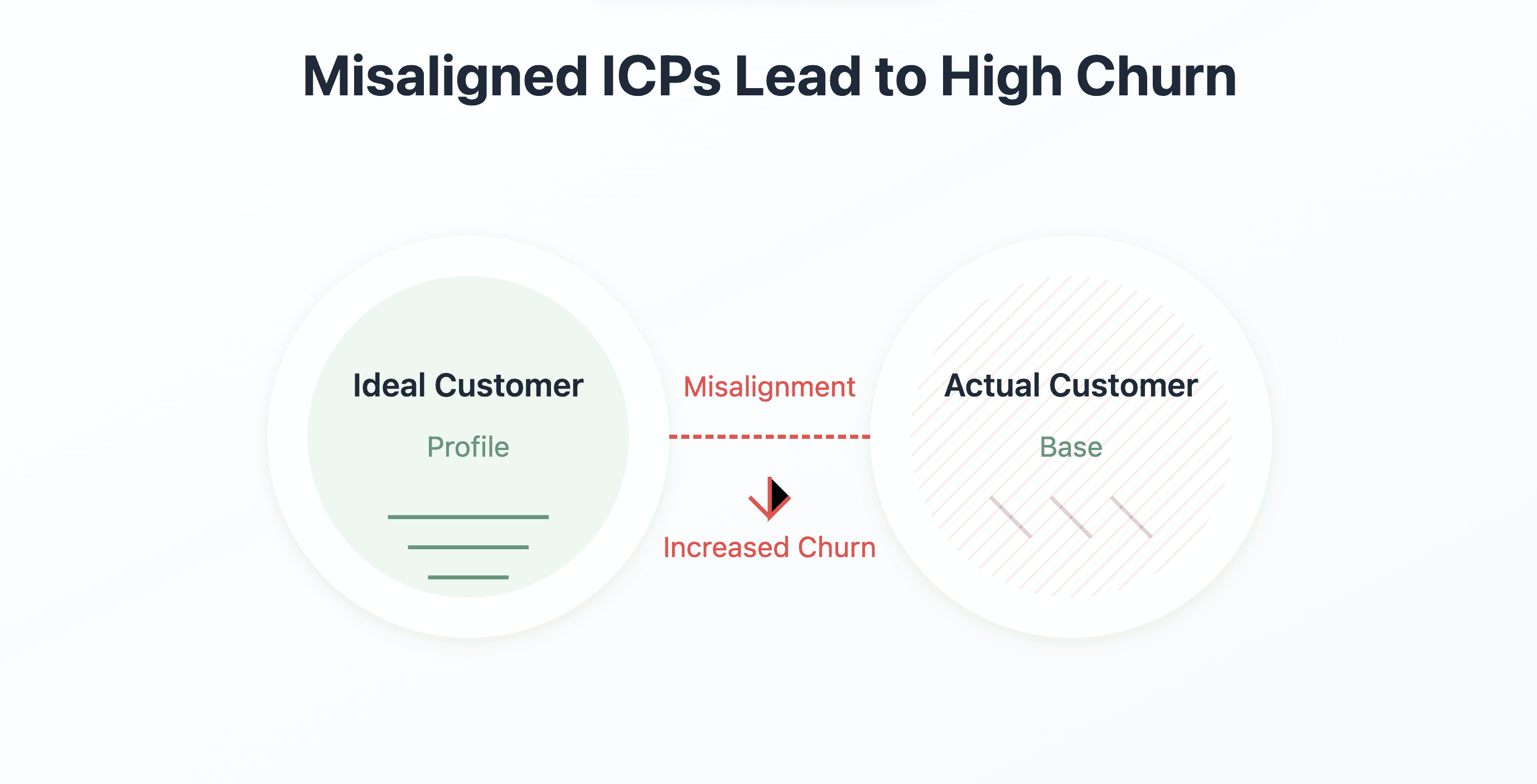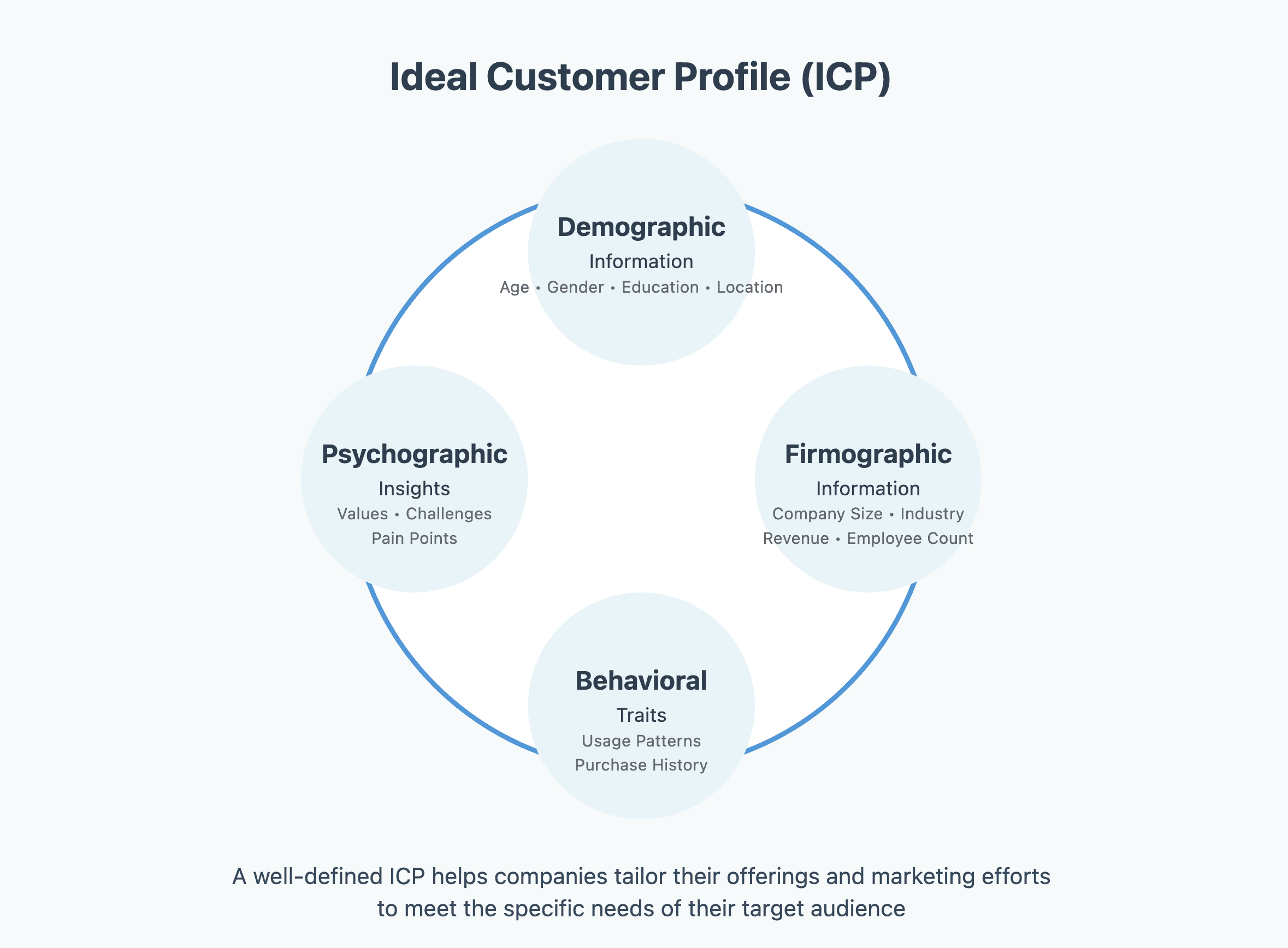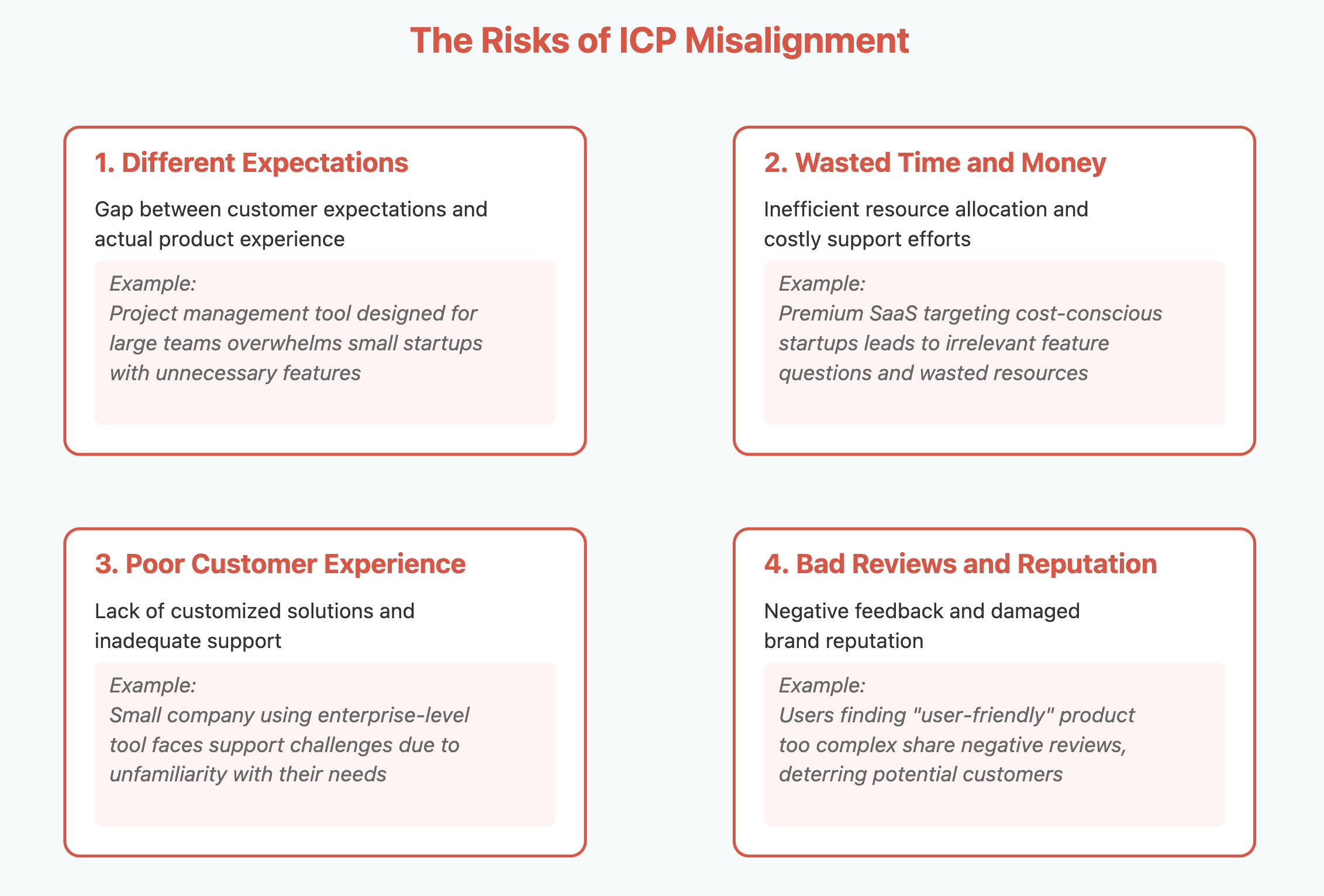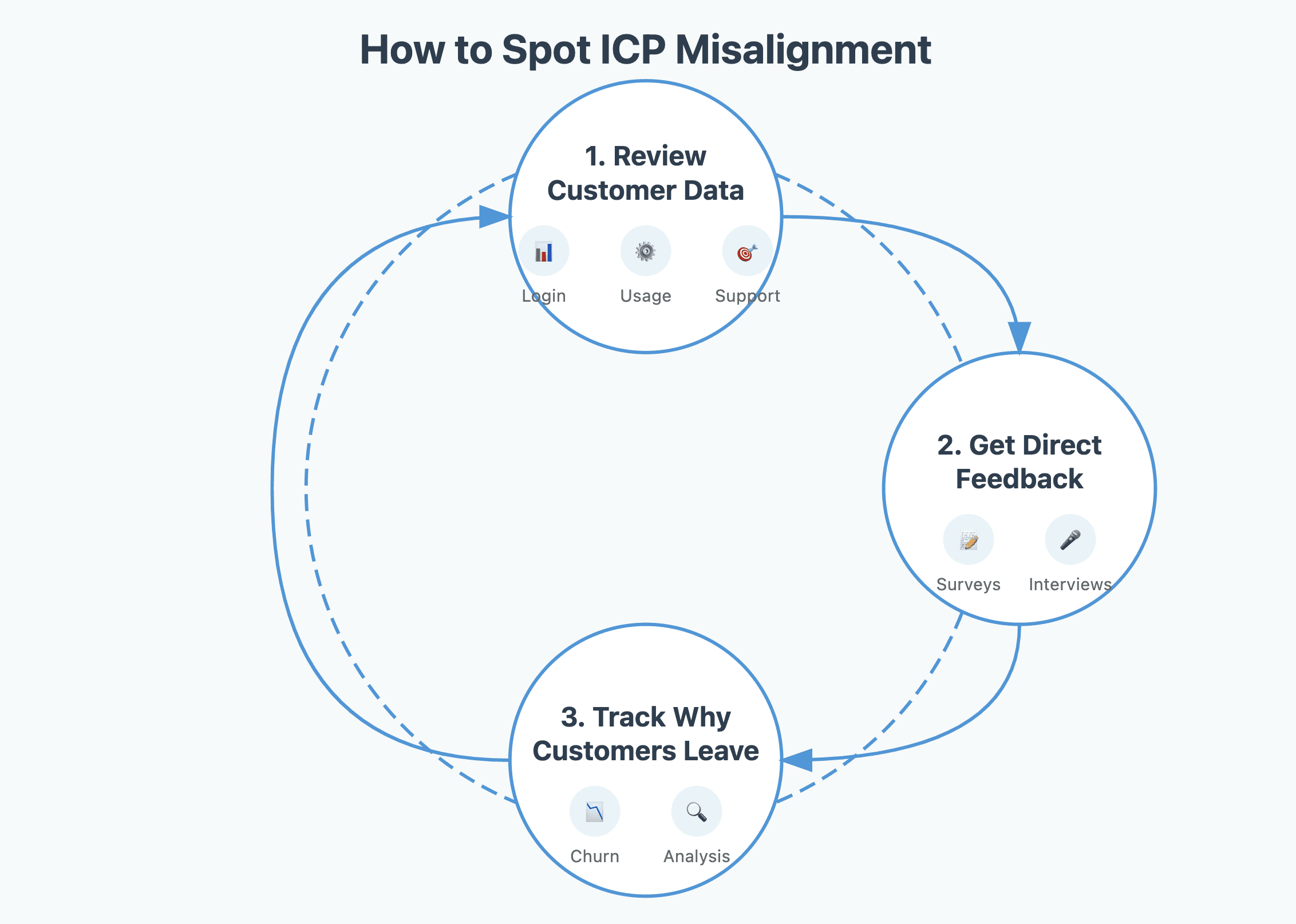
Why Misaligned Ideal Customer Profiles Lead to High Churn

by
Wiktoria Slowikowska
Oct 30, 2024
Identify and convert your most valuable users
Sign Up
Understanding your customer is vital for long-term success. At the core of this understanding is the Ideal Customer Profile (ICP), which represents the type of customer that will gain the most value from your product.
However, when an ICP doesn't match your actual customer base, it can lead to significant issues, especially high customer churn. This article explores why misaligned ICPs result in increased churn rates and offers solutions for businesses to realign their strategies effectively.

What Is an Ideal Customer Profile (ICP)?

An Ideal Customer Profile (ICP) outlines the characteristics of customers who would benefit most from your product or service. A solid ICP includes:
Demographic Information: Details like age, gender, education, and location.
Firmographic Information: Attributes such as company size, industry, revenue, and number of employees for B2B SaaS.
Behavioral Traits: Information on how users engage with your product, including usage patterns and purchase history.
Psychographic Insights: Understanding customers' values, challenges, and pain points that your product can solve.
A well-defined ICP allows companies to tailor their offerings, customer success strategies, and marketing efforts to meet the specific needs of their target audience. However, if a company's ICP is not aligned with its actual customer base, several problems can arise.
The Risks of Misalignment

1. Different Expectations
A misaligned ICP often results in a gap between what customers expect and what they experience with your product.
Expectations vs. Reality: If a SaaS company primarily serves large businesses but markets its product to small startups, those startups may have very different needs. If they discover the product doesn't meet their requirements, they may feel deceived, leading to dissatisfaction and churn.
Example: A project management tool designed for large teams might overwhelm a small startup with unnecessary features, causing them to abandon the product after a short trial.
2. Wasted Time and Money
Misaligned ICPs can lead to inefficiencies in resource allocation. Customer success teams may waste valuable time trying to support customers who aren't likely to benefit from the product.
Costly Support Efforts: When customer success teams spend time assisting clients outside the ideal profile, they may struggle to provide the tailored support necessary for satisfaction and product adoption.
Example: If a company targets cost-conscious startups with a premium SaaS product, they may find themselves repeatedly answering questions about features irrelevant to the user's needs, wasting time and resources.
3. Poor Customer Experience
When customer success teams assist customers who don’t match the product's intended use, it often results in a negative experience.
Lack of Customized Solutions: Misaligned customers may not receive the support they need for successful product implementation, leading to frustration.
Example: A small company using an enterprise-level tool may feel unsupported because the customer success team isn’t familiar with the specific challenges of smaller organizations.
4. Bad Reviews and Reputation Damage
Customer dissatisfaction can lead to negative reviews and word-of-mouth, harming a brand's reputation.
Churn Leads to Negative Feedback: When customers churn due to misalignment, they are likely to express their frustrations online, deterring potential new customers.
Example: A user who finds a product marketed as user-friendly overly complicated may voice their disappointment on social media, affecting the company's image and scaring off prospective clients.
How to Spot Misalignment

1. Review Customer Data
The first step in addressing misalignment is analyzing your existing customer data. Companies should compare who their customers actually are with who they think they are.
Engagement Metrics: Look at metrics like login frequency, feature usage, and support requests to see how well the product meets different users' needs.
2. Get Direct Feedback
Engaging with customers through surveys and interviews can provide valuable insights into their motivations, challenges, and experiences with the product.
Feedback Loop: Regularly gather insights from users to ensure you address any changes in customer needs.
3. Track Why Customers Leave
Understanding why customers leave can highlight issues of misalignment. Conducting exit interviews or sending churn surveys can help capture reasons for their departure.
Identify Trends: Analyzing churn reasons can reveal patterns of dissatisfaction that point to areas where the product may not be meeting expectations.
How to Realign Your ICP

1. Update Your ICP Based on Data
After gathering feedback and data, revise your ICP to reflect these insights. This may mean adjusting demographic, firmographic, and psychographic attributes based on real customer behavior.
Data-Driven Adjustments: Use insights to create a more accurate representation of your ideal customer, ensuring it aligns with their actual needs.
2. Segment Your Customers
Not all customers will fit the same profile. Consider dividing your customer base into different segments based on shared characteristics.
Personalized Strategies: By developing multiple ICPs, you can create tailored engagement strategies for each group, boosting overall customer satisfaction and retention.
3. Modify Customer Support Strategies
Once you've updated your ICP, ensure your customer support strategies reflect this new understanding. Provide support and resources tailored to the newly defined customer profiles.
Focus on Customer Needs: Customer success teams should highlight how the product meets the specific needs of the updated ICP, reinforcing the value of the product and enhancing user satisfaction.
4. Train Your Support Teams
Ensure that customer success teams are knowledgeable about the needs and challenges of the new ICPs. Training should emphasize how to best support these customers.
Ongoing Training: Hold regular training sessions to keep customer success teams updated on customer insights and product changes.
Embracing Continuous Improvement
1. Create a Feedback System
Regularly solicit feedback from customers to refine your ICP further. Customer needs and market conditions change, and businesses must stay adaptable.
Iterate on Feedback: Use customer feedback to improve product offerings and ensure alignment with customer expectations.
2. Keep an Eye on Key Metrics
Monitor important performance indicators (KPIs) related to customer satisfaction and churn. Metrics like Net Promoter Score (NPS), Customer Satisfaction Score (CSAT), and churn rate can provide insights into how well your business aligns with its ICP.
Actionable Insights: Use this data to make informed decisions and proactively address potential churn before it occurs.
A Real-World Example: Slack
Consider Slack, originally designed for team communication. It attracted various customers, from small startups to large enterprises. However, Slack initially misaligned its ICP by focusing heavily on the needs of bigger organizations while neglecting the specific needs of smaller teams.
As customer feedback came in, Slack recognized that smaller teams found its features overwhelming and often unhelpful. To realign its ICP, Slack began to segment its customer base more effectively, tailoring its onboarding and support resources for smaller businesses.
This realignment improved user experience, boosted customer retention, and ultimately reduced churn rates. They also enhanced their marketing strategies to directly address smaller teams, leading to a more engaged user base.
Conclusion
Misaligned Ideal Customer Profiles can lead to serious issues, including high churn rates, wasted resources, and negative customer experiences. Understanding the importance of a well-defined ICP, conducting regular assessments, and remaining flexible to customer needs are critical for any SaaS business aiming for long-term success.
By realigning the ICP to match the actual customer base, companies can enhance their customer support strategies, improve user experiences, and ultimately reduce churn. Remember, in the ever-changing landscape of SaaS, the key to retaining customers lies in understanding their unique needs. A well-defined and regularly updated ICP not only drives engagement but also fosters lasting relationships that contribute to sustainable growth.
FAQs
What defines an Ideal Customer Profile (ICP)?
An Ideal Customer Profile (ICP) outlines the characteristics of customers who would benefit the most from a company’s product, including demographic, firmographic, and behavioral traits.What problems arise from a misaligned ICP?
Misaligned ICPs can lead to high churn rates, wasted resources, poor customer experiences, and negative brand reputation.How can businesses identify a misaligned ICP?
Businesses can identify misalignment by analyzing customer engagement data, conducting surveys, and tracking reasons for customer churn.What steps can companies take to realign their ICP?
Companies should update their ICP based on data insights, segment their customer base, adapt support strategies, and train their teams accordingly.




